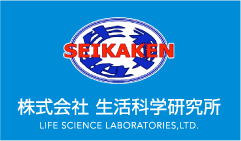06-6531-1881
What does “Quality Assurance (QA)” mean?
Quality assurance is a systematic process for checking various kinds of data generated during the course of a study and for reviewing study-related documents, such as final reports, to assure the quality and reliability of that study. At Life Science Laboratories, Ltd. (LSL), an in-house Quality Assurance Unit is available to assure the quality of your preclinical studies for regulatory applications.
Why do you use Japanese people as participants in human patch tests
(including dermal application tests)?
The Guide to Quasi-drug and Cosmetic Regulations in Japan (2008) requires the use of Japanese people as participants in human patch tests.
In human patch tests, if changes in the skin appear, two possible causes are considered, i.e., primary skin irritation or allergic reaction.
Primary skin irritation is a non-allergic reaction the first time the skin is exposed to a test substance. It is known that primary skin irritation varies among racial groups.
Allergic reactions are excessive responses of pre-existing antibodies to the allergen (test substance) and may vary according to the environmental conditions such as atmosphere, water and dietary habits.
What are the appropriate dose levels for a single oral dose toxicity study?
For test substances expected to be of low toxicity, a single dose level of 2000 mg/kg, a dose that is commonly recommended by various guidelines, is used for single oral dose toxicity studies (1000 mg/kg is also acceptable in studies for SEK application).
If the toxic dose level is below 2000 mg/kg, the test substance is administered in graduating doses, and the dose levels are selected according to the OECD Guideline TG 420 “Fixed dose procedure”.
Why are there different types of skin sensitization studies?
Study methods vary depending on whether or not intracutaneous administration is feasible according to the form, etc. of the test substance (sample).
Please note that test results obtained using the Buehler method cannot be used to obtain an SEK mark.
What kinds of bacteria are used in Ames (bacterial reverse mutation) tests?
The following 5 bacterial strains are used in Ames tests. Tests are available using a minimum of one bacterial strain.
| Types of bacteria | Bacterial strains |
|---|---|
| Salmonella typhimurium | TA1535 TA1537 TA98 TA100 |
| Escherichia coli | WP2uvrA |
What volume of the test substance (sample) is required for a study?
The following are a rough guide of sample volumes:
※Please note that these are just rough values. Please feel free to inquire about other studies.
| Type of study | Required sample volume |
|---|---|
| Single oral dose toxicity study (using a single dose level) | ≥ 3 g (mL) |
| Primary skin irritation study | ≥ 5 g (mL) |
| Cumulative skin irritation study | ≥ 3 g (mL) |
| Phototoxicity study | ≥ 3 g (mL) |
| Skin sensitization study | ≥ 10 g (mL) |
| Photosensitization study | ≥ 10 g (mL) |
| Eye irritation study | ≥ 3 g (mL) |
| Ames (bacterial reverse mutation) test | ≥ 3 g (mL) |
| Chromosomal aberration test | ≥ 5 g (mL) |
| Micronucleus test | ≥ 10 g (mL) |
| Cytotoxicity test | ≥ 5 g (mL) |
| Human patch test (application test) | ≥ 10 g (mL) |
A sample volume required for a pharmacology/efficacy study is determined according to the duration of that study and number of animals used.
The required volume will be notified at preparation of the protocol.
What are the safety standards of the Japan Textile Evaluation Technology Council
(JTETC)?
The safety of antibacterial finished products is considered to be acceptable if the finishing agents used for the products meet the safety standards of the JTETC and the concentrations of the agents used are below safety-assured levels (below 1/2 the safety-assured levels if diluted agents are used for safety evaluation). Only when safety of the products cannot be confirmed by evaluation of antibacterial finishing agents used, such antibacterial finished products are used to evaluate the safety.
The following 4 test items are used for evaluation of the safety of finishing agents:
1.Acute oral toxicity test
The test substance is administered once orally to rats or mice. The LD50 value (or approximate lethal dose) is calculated based on the mortality rate. The value should be 2000 mg/kg or greater.
2.Primary skin irritation test
The test substance is applied to rabbit skin and the skin reactions are evaluated. There should be no or only mild irritation, indicated by a Primary Irritation Index (PII) of 0-2.
3.Mutagenicity test
In Ames test using bacteria, the results should be negative (no mutagenicity). Chromosomal aberration and micronucleus tests are conducted if necessary.
4.Skin sensitization test
Tests are conducted using the adjuvant and patch test method or maximization test method and the results should be negative.
Can the test duration be shortened?
The test duration is shortened to the extent possible.
If the results are required early, an interim or flash report can be prepared.
When studies with different durations are requested, when will the reports become available?
Study reports are available at the end of each study.
Does “free quotation” mean as many estimates as I want for free?
Yes, of course. Please feel free to consult us.
How is the test substance handled after completion of the study?
In principle, test substances are not disposed of at Life Science Laboratories, Ltd. You may choose to have test substances returned after study completion or stored for an agreed period at an additional cost (see the study request form). After termination of the storage period, we will contact you so you can again select Return or Extension of storage (fees apply).
Is intraocular pressure (IOP) measured only without anesthesia?
Since IOP varies with the use of an anesthetic, accurate IOP may not be obtained under anesthesia.
How many animals per group do you use for the tear volume measurement test?
At least 3 animals per group are required. However, using the minimum number of animals (3 animals/group) only a trend may be obtained.

-
LIFE SCIENCE LABORATORIES,LTD.
7F Okazakibashi Central Bldg.(Medical Center Okazakibashi)
3-1-1 Nishi-hommachi, Nishi-ku, Osaka 550-0005, JapanTEL.+81-6-6531-1881 FAX.+81-6-6533-1776









